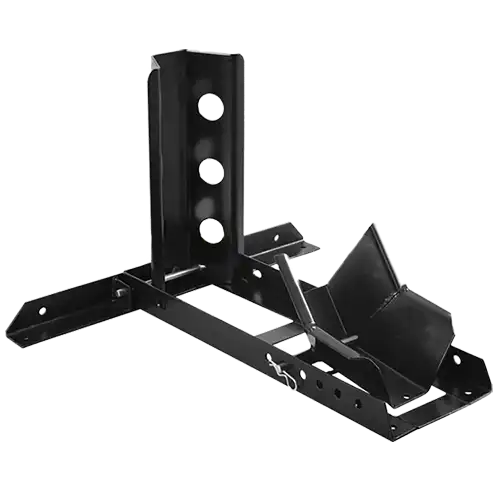Understanding Motorcycle Wheel Chocks: Types and Benefits
Varieties of Wheel Chocks
Motorcycle wheel chocks come in a plethora of designs, each tailored to specific needs and preferences. Stationary chocks, often bolted to the floor of a garage or trailer, provide unwavering stability. Portable options offer flexibility, allowing riders to secure their bikes in various locations. Adjustable chocks accommodate different wheel sizes, while folding models prioritize compact storage. Some advanced designs incorporate locking mechanisms for added security, while others feature integrated tie-down points for comprehensive restraint systems.
Advantages of Using a Wheel Chock
The benefits of employing a wheel chock or motorcycle wheel clamp extend far beyond mere convenience. These devices significantly enhance safety by preventing unwanted movement, particularly crucial during maintenance tasks or when transporting motorcycles. They distribute the bike's weight evenly, reducing stress on the suspension and tires during extended storage periods. For riders with limited strength or mobility, wheel chocks facilitate easier loading and unloading processes. Additionally, they protect the motorcycle's finish by eliminating the need for excessive strapping or makeshift supports that could potentially mar the paintwork.
Selecting the Ideal Wheel Chock
Choosing the right wheel chock involves considering several factors. The diameter and width of your motorcycle's front wheel play a crucial role in determining compatibility. Weight capacity is another vital aspect, ensuring the chock can adequately support your bike. For those who own multiple motorcycles or frequently work on different models, an adjustable chock offers versatility. Material composition impacts durability and portability, with options ranging from lightweight aluminum to robust steel constructions. Riders should also consider additional features like anti-slip surfaces, weather resistance, and ease of assembly when making their selection.
Step-by-Step Setup Guide for Motorcycle Wheel Chocks
Preparing for Installation
Before diving into the setup process, it's crucial to gather all necessary tools and materials. Typically, you'll need a wrench set, screwdriver, and possibly a drill if mounting the motorcycle wheel chock to a surface. Carefully read the manufacturer's instructions, as they often contain specific guidance tailored to your model. Choose a suitable location for your wheel chock, ensuring it's on a level surface with ample space around it for maneuvering your motorcycle. If you're installing in a trailer or van, consider the vehicle's weight distribution and secure mounting points.
Installation Techniques
The installation process varies depending on the type of wheel chock you've chosen. For permanent installations, start by marking the mounting holes on your chosen surface. Drill pilot holes if necessary, then secure the chock using appropriate bolts or screws. Ensure all fasteners are tightened to the manufacturer's specifications. For portable chocks, assembly might involve attaching legs or stabilizers. Pay close attention to any adjustable components, such as wheel cradles or locking mechanisms, and set them to match your motorcycle's specifications. Double-check all connections and moving parts for smooth operation before use.
Testing and Adjustments
Once your wheel chock is installed, it's imperative to conduct a thorough test before entrusting it with your motorcycle. Start by slowly rolling your bike's front wheel into the chock, observing how it engages. The wheel should nestle securely, with the chock providing firm resistance against forward and backward movement. If your chock features adjustable components, fine-tune them for optimal fit and stability. Pay attention to how easily you can load and unload the motorcycle, making adjustments as needed for comfortable use. Remember, a properly set up wheel chock should inspire confidence in its ability to keep your bike upright and secure.
Maximizing the Use of Your Motorcycle Wheel Chock
Best Practices for Loading and Unloading
Mastering the art of loading and unloading your motorcycle from a wheel chock or motorcycle wheel clamp is crucial for safety and efficiency. Approach the chock at a slow, controlled pace, aligning your front wheel with the cradle. As the wheel enters the chock, you'll feel resistance; continue pushing forward until the bike is securely nestled. Many riders find it helpful to apply the front brake while easing off the throttle for a smooth entry. When unloading, gently rock the motorcycle backward while supporting its weight. Practice these movements in a safe environment to build confidence and muscle memory.
Maintenance and Care Tips
To ensure longevity and optimal performance of your motorcycle wheel chock, regular maintenance is key. Periodically inspect all components for signs of wear or damage, paying special attention to moving parts and fasteners. Keep the chock clean, removing any dirt or debris that could affect its operation. If your chock is exposed to the elements, consider applying a protective coating to prevent rust and corrosion. Lubricate pivot points and adjustable mechanisms as recommended by the manufacturer. By incorporating these maintenance habits into your routine, you'll extend the life of your wheel chock and maintain its reliability.
Integrating Wheel Chocks with Other Security Measures
While a wheel chock provides excellent stability, combining it with additional security measures offers comprehensive protection for your motorcycle. Consider using tie-down straps in conjunction with the chock to further immobilize your bike during transport. For long-term storage, a disc lock or chain through the wheel and chock can deter theft. If you're using the chock in a garage or workshop, explore options for integrating it with a broader motorcycle lift system for enhanced maintenance capabilities. By thinking holistically about your motorcycle's security and stability, you can create a setup that offers peace of mind in any situation.
Conclusion
Mastering the use of a motorcycle wheel chock is an essential skill for any rider committed to proper motorcycle care and safety. By understanding the various types available, following a meticulous setup process, and adopting best practices for usage and maintenance, you're ensuring the longevity and security of your prized two-wheeled companion. Remember, a well-chosen and correctly installed wheel chock not only simplifies your maintenance routines but also provides invaluable peace of mind during storage and transportation. Embrace this tool as a fundamental part of your motorcycling arsenal, and enjoy the benefits of a stable, secure ride for years to come.
Contact Us
Ready to elevate your motorcycle maintenance and storage game? For more information on our range of high-quality motorcycle wheel chocks and other innovative tools, don't hesitate to reach out. Contact us at info@runva.com.cn to discover how our products can enhance your riding experience and motorcycle care routine.

_1737625693698.webp)


